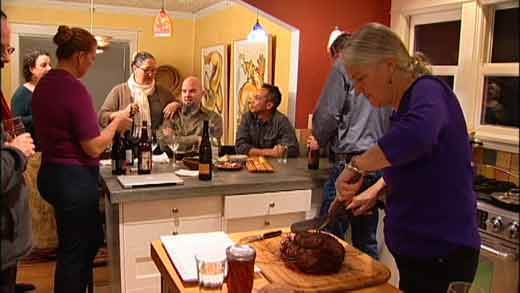In the final segment of this pastured pig to plate series, Kathleen Bauer hosts a celebration BBQ pork roast dinner to honor the life of Roger the pig, and to thank those who were involved in the project. As you see in the video, there’s a lot of meat that comes from half a 300 pound Berkshire Cross heritage pig. The main dish was a pork roast that was slow cooked on the barbecue, and turned out to be incredibly tender and flavorful (a shout out to the cook who also did a superb job!).
While there are a number of legitimate reasons sustainable food advocates argue for the benefits of diversified, small-scale, less chemical intensive, farming practices— in contrast to large-scale, industrial farming— the crops and livestock products happen to taste better, and arguably are healthier to eat.
Pastured pigs not raised under factory confinement are allowed to live as pigs naturally wish to live. Pigs are widely considered to be intelligent creatures that are curious and like to explore, chew on straw, and graze and root in pastures. They are social creatures. The breed of a pig, being pasture raised, and being humanely slaughtered, these are important factors in producing a noticeable quality of flavor and tenderness in the final meat product.
To watch the full Pig to Plate series:
- Pastured Pig to Farm: The Farm
- Pastured Pig to Plate: Butchering the Pig
- Pastured Pig to Plate: The BBQ Pork Roast Celebration
Video Transcript
All of this is Roger. As part of the process in the project of Pasture to Table, I wanted to have everyone who participated in the project here for dinner to have a, a meal together and celebrate Roger’s life, in essence and what he’s given us.
And the wonderful food that Clare has provided us by raising Roger. I’ve been blogging on my blog, Good Stuff NW, I’ve been blogging about the whole process and I have had a great response from people.
Okay, there it is.
Awesome, Dave. Do you want to put it over here?
There has been no blowback on “How could you do this?” No horrified comments on Facebook or Twitter or on the blog. Vegetarians have made comments about how moved they are by what I’m doing. A lot of people have expressed, you know, rightfully or wrongfully, they’ve expressed admiration for someone who’s willing to go through this process and have that experience. I’ve had a lot of people say they couldn’t do that, it would just be too much for them, and, and basically people have been very appreciative that I’ve been able to tell the story of Roger and what it’s like to follow an animal from, you know, it’s youth, you know, through the kill to the table. Okay, now this is the tricky part where I try to lift it.
But it’s not 100 percent grass fed.
You got it, you got it. You got it.
Intact. Oh, it’s going to work. Yes! Awesome. I’m all about the experience. I’m all about finding out what it’s like to do stuff and writing about it and, and sharing that experience with my readers, whether, you know they’re readers on my blog or whoever. Ding, ding, ding! We need to go grab a glass, whatever you’re drinking or whatever you want to drink, go sit down, and I’ll bring Roger out.
All right, Roger.
That sound, that sound appropriate? That sounds appropriate. Okay, here comes Roger, guys. Are we ready to toast Roger? Fred, sit down. Dave, sit somewhere. Okay. And here is Roger. Yay.
Hi Roger.
Hi Roger.
Cheers.
Cheers.
Thanks, Kathleen, for having us.
So, yeah, sure, of course I’d do it again. You know, it would be interesting to do it with a sheep. It’d be interesting to do it with a calf.
This 1 is calling my name. Am I allowed to do that?
It’s a fascinating process and each 1 is different, you know, not just because each animal is different but just each creature is different in the way it behaves and all that stuff. So, I’m really interested in that.
Most of the videos featured on Cooking Up a Story were produced, filmed, and edited by Rebecca Gerendasy. Fred Gerendasy contributed as a writer to many of the posts and occasionally as the interviewer. Visit Rebecca Gerendasy Clay – Art and Fred Gerendasy Photography to see their current work.

